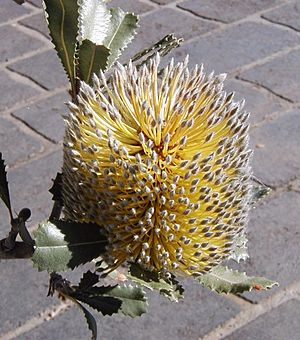Desert banksia facts for kids
Quick facts for kids Desert banksia |
|
|---|---|
 |
|
| Banksia ornata in Mount Annan Botanic Garden. | |
| Scientific classification | |
| Genus: |
Banksia
|
| Species: |
ornata
|
| Synonyms | |
|
|

The Desert Banksia (Banksia ornata) is a type of shrub that grows only in south-eastern Australia. The Ngarrindjeri people, who live in the Lower Murray region of South Australia, call this plant yelakut. It has thin bark and leaves that are shaped like a narrow egg with jagged edges. Its flowers are cream-coloured and grow in a tall, round spike. After flowering, the spike forms up to fifty seed pods, called follicles. These pods are surrounded by the dried parts of the old flowers.
What Does It Look Like?
The Desert Banksia is a shrub that usually grows up to about 3 meters (10 feet) tall. It has thin, grey bark. Its stems are hairy when they are young, but they become smooth later.
The leaves are narrow and shaped like an egg, or sometimes like a wedge. They are 30 to 100 millimeters (1.2 to 3.9 inches) long and 4 to 25 millimeters (0.16 to 0.98 inches) wide. Each leaf has a small stem, called a petiole, that is 5 to 10 millimeters (0.2 to 0.4 inches) long.
The flowers are cream-coloured. They grow in a wide, cylinder-shaped spike. This spike is 50 to 110 millimeters (2 to 4.3 inches) long and 70 to 80 millimeters (2.8 to 3.1 inches) wide when the flowers open. Small, hairy leaves called bracts grow at the bottom of the flower spike. However, these bracts fall off before the flowers open.
Each flower has a part called a perianth, which is 30 to 35 millimeters (1.2 to 1.4 inches) long. The pistil, which is the female part of the flower, is 35 to 38 millimeters (1.4 to 1.5 inches) long and slightly curved.
Desert Banksia flowers mostly in winter and spring, but it can flower in most months of the year. After flowering, up to fifty oval-shaped seed pods, called follicles, grow on each spike. These pods are 15 to 20 millimeters (0.6 to 0.8 inches) long and 10 to 15 millimeters (0.4 to 0.6 inches) wide. They are surrounded by the old, dried flower parts.
Naming the Plant
The scientific name Banksia ornata was first officially described in 1854. This description was made by Carl Meissner, based on notes from Ferdinand von Mueller. It was published in a journal called Linnaea: ein Journal für die Botanik in ihrem ganzen Umfange, oder Beiträge zur Pflanzenkunde.
The second part of the scientific name, ornata, comes from a Latin word meaning "decorated". This name refers to the plant's pretty flowers and leaves.
Where It Grows
The Desert Banksia is common in western Victoria and in South Australia. In South Australia, you can find it in the south-east part of the state, south of Nuriootpa. It also grows on the lower Eyre Peninsula, Kangaroo Island, and east of Adelaide.
In Victoria, it is found only in the far west. It grows mainly between Murrayville and the Grampians. This plant usually grows in sandy, well-drained soils. It is often found in mallee (areas with many small, multi-stemmed eucalyptus trees) and heathland environments.
How It Lives
Birds that feed on nectar (a sweet liquid from flowers) are very attracted to the Desert Banksia. Some of the birds seen feeding on its flowers include:
- The Red wattlebird (Anthochaera carunculata)
- The Brown-headed honeyeater (Melithreptus brevirostris)
- The White-naped honeyeater (Melithreptus lunatus)
- The Silvereye (Zosterops lateralis)
See also
 In Spanish: Banksia del desierto para niños
In Spanish: Banksia del desierto para niños
- Taylor, Anne; Hopper, Stephen (1988). The Banksia Atlas (Australian Flora and Fauna Series Number 8). Canberra: Australian Government Publishing Service. ISBN 0-644-07124-9.

